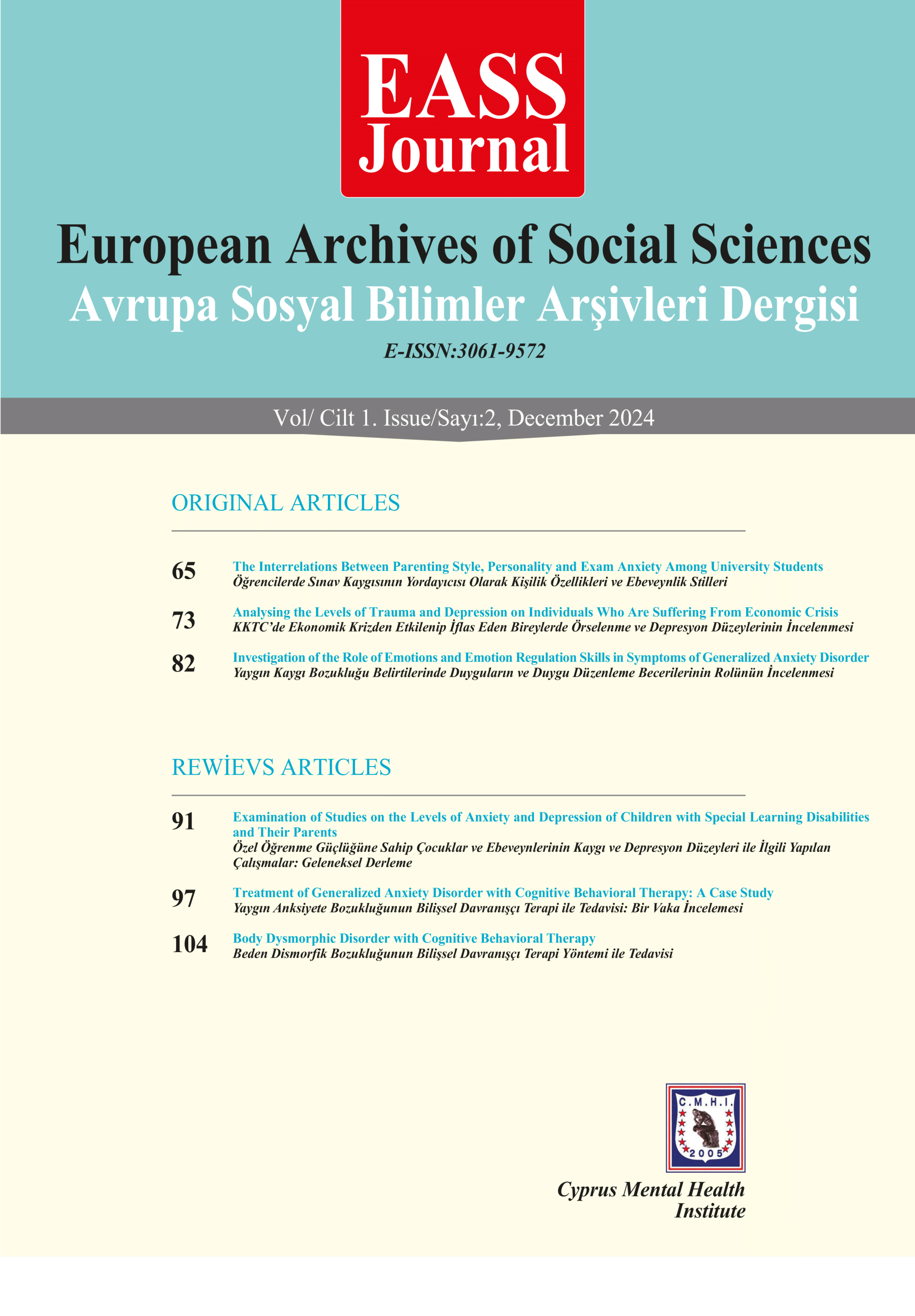The Treatment of Generalized Anxiety Disorder with Cognitive Behavioral Therapy: A Case Study
DOI:
https://doi.org/10.35365/eass.24.2.05Keywords:
Generalized anxiety disorder, cognitive behavioral therapy, peer bullying, sexual identity, stress copingAbstract
Abstract
This article examines the experience of a 16-year-old high school student, Mr. B, who has been dealing with generalized anxiety disorder and the application of Cognitive Behavioral Therapy (CBT) in his treatment process. Mr. Bfaced various challenges, including family conflicts, peer bullying, and identity questions, all of which negatively impacted his emotional balance and overall quality of life. Through the course of treatment, CBT provided methods for managing negative thoughts and improving stress-coping skills, resulting in significant progress. The study details how CBT helped reduce Mr. B’s anxiety, restore emotional stability, and address the difficulties he faced in social relationships. Therapeutic interventions aimed to strengthen both his psychological and social functioning, leading to positive outcomes. This case highlights the effectiveness of CBT in treating anxiety disorders in young individuals and underscores the importance of such clinical practices.
References
Beck, A. T., Emery, G., & Greenberg, R. L. (2005). Anxiety disorders and phobias: A cognitive perspective. Basic Books.
Beesdo, K., Knappe, S., & Pine, D. S. (2009). Anxiety and anxiety disorders in children and adolescents: Developmental issues and implications for DSM-V. Psychiatric Clinics, 32(3), 483-524.
Borkovec, T. D., Robinson, E., Pruzinsky, T., & DePree, J. A. (1983). Preliminary exploration of worry: Some characteristics and processes. Behaviour Research and Therapy, 21(1), 9–16.
Ersoy, F., Edirne, T.ve Oğuz, T. F. (2003). Birinci basamakta anksiyete bozuklukları. Sted, 12 (9), 326-327.
Garber, J., Keiley, M. K. & Martin, N. C. (2002) Developmental tra- jectories of adolescent’s symptoms: Predictors of change. J Consult Clin Psychol, 70: 79-95.
Ginsburg, G. S., Becker, K. D., & Keeton, C. P. (2008). The Child Anxiety Prevention Study: Intervention model and primary outcomes. Journal of Consulting and Clinical Psychology, 76(2), 282–297.
Hofmann, S. G., Asnaani, A., Vonk, I. J., Sawyer, A. T., & Fang, A. (2012). "The Efficacy of Cognitive Behavioral Therapy: A Review of Meta-Analyses." Cognitive Therapy and Research, 36(5), 427-440.
Karamustafaoğlu, O. ve Yumrukçal, H. (2011). Depresyon ve anksiyete bozuklukları. Şişli Etfal Hastanesi Tıp Bülteni, 45 (2), 65-74.
Kendall, P. C., Chansky, T. E. & Freidman, M. (1990) Treating anxiety disorders in children and adolescents. Child and Adolescent Therapy: Cognitive Behavioral Procedures, PC Kendall (Ed), The Guilford Pres, New York, s.131-157.
Kessler, R. C., Berglund, P., Demler, O., Jin, R., Merikangas, K. R., & Walters, E. E. (2005). Lifetime prevalence and age-of-onset distributions of DSM-IV disorders in the National Comorbidity Survey Replication. Archives of General Psychiatry, 62(6), 593-602.
Konkan, R., Şenormanci, Ö., Güçlü, O., Aydın, E. ve Sungur, M. Z. (2013). Yaygın anksiyete bozukluğu-7 (YAB-7) testi türkçe uyarlaması, geçerlik ve güvenilirliği. Noropsikiyatri Arşivi, 50 (1).
Öztürkler, M., & Karaaziz, M. (2021). Evaluation of the ‘Blow’ Movie from the Cognitive Behavioral Psychotherapy Perspective, Cyprus Turkish Journal of Psychiatry & Psychology, 3(4): 298-303
Roelofs, K., Lee, C., Ruijten, T., Lobbestael, J., & Van Breukelen, G. (2010). The mediating role of early maladaptive schemas in the relation between quality of attachment relationships and symptoms of depression in adolescents. Behavioural and Cognitive Psychotherapy, 38(4), 471–490.
Savin-Williams, R. C. (2017). "Mostly Straight: Sexual Fluidity Among Men." Harvard University Press.
Sevinçok, L. (2007). Yaygın anksiyete bozukluğunun nörobiyolojisi. Klinik Psikiyatri, 10 (5), 3-12.
Somers, J. M., Goldner, E. M., Waraich, P., & Hsu, L. (2006). Prevalence and incidence studies of anxiety disorders: A systematic review of the literature. Canadian Journal of Psychiatry, 51(2), 100-113.
Stein, M. B., Sareen, J., & Clark, D. A. (2017). Panic disorder in the community: An overview of epidemiology, comorbidity, and course. CNS Spectrums, 22(1), 1-9.
Suadiye, Y. ve Aydın, A. (2009). Anksiyete bozukluğu olan ergenlerde bilişsel hatalar. Klinik Psikiyatri Dergisi, 12 (4), 172-179.
Weems, C. F. & Watts, S. E. (2005) Cognitive models of childhood anx- iety. Anxiety Disorder Research, M Velotis (Ed), Hauppauge, NY: Nova Science Publishers Inc, s.205-232.
Downloads
Published
How to Cite
Issue
Section
License
Copyright (c) 2024 Psk. Yağmur Sena Balkesen, Doç. Dr. Meryem Karaaziz

This work is licensed under a Creative Commons Attribution 4.0 International License.





 The journal is licensed under a
The journal is licensed under a 